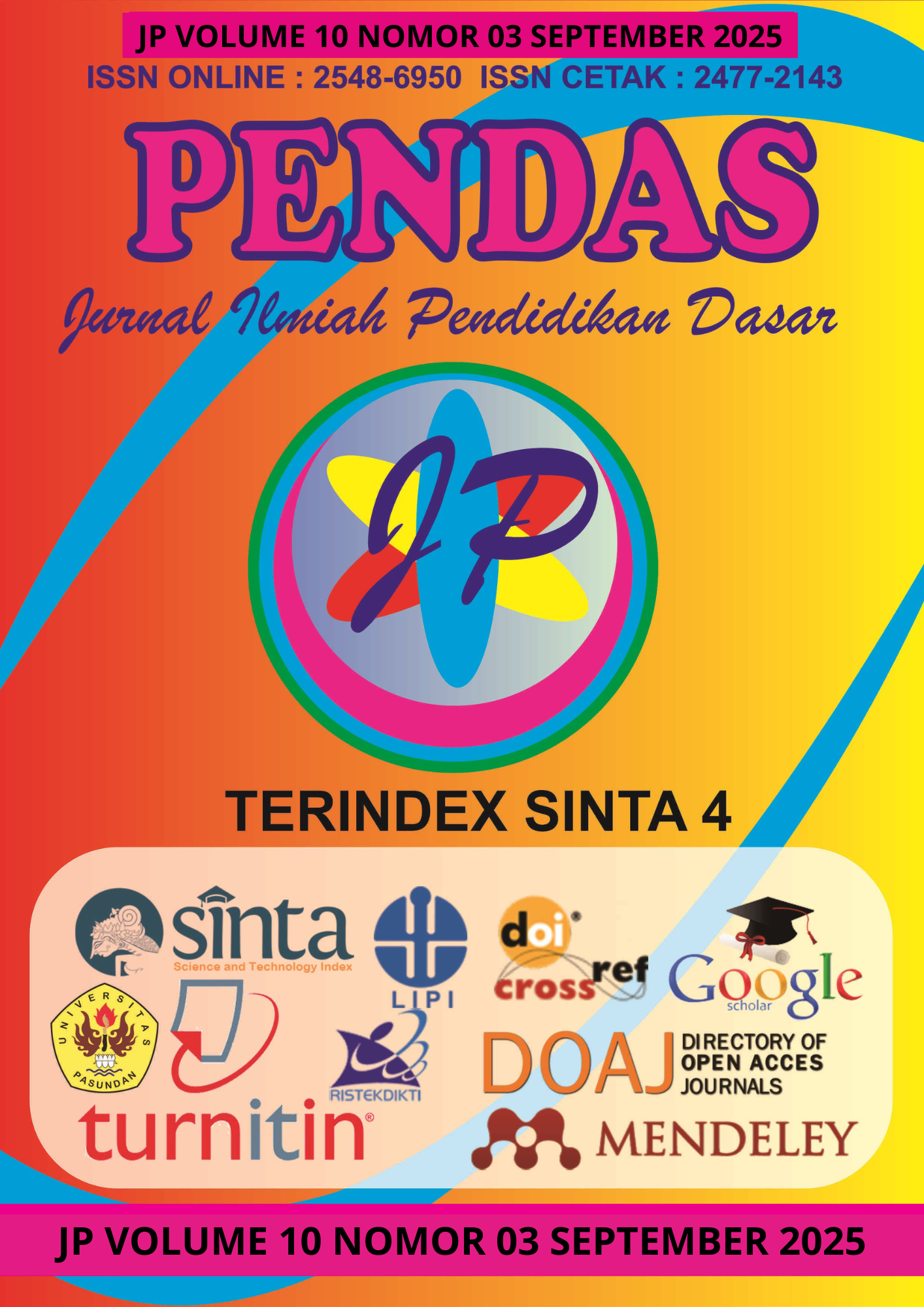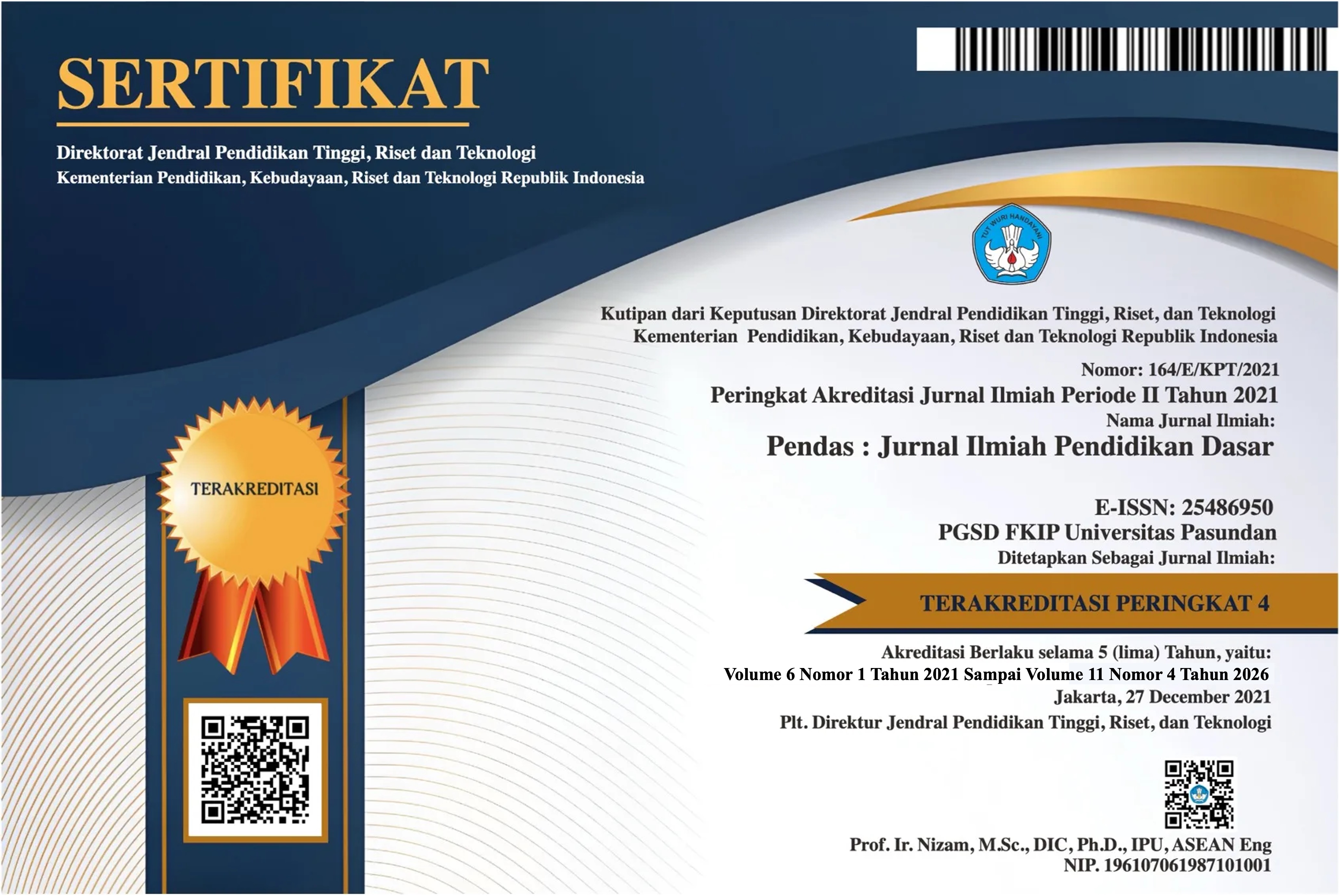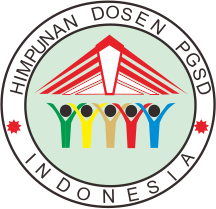PENGARUH MEDIA POWERPOINT INTERAKTIF TERHADAP KEMAMPUAN KOGNITIF SISWA KELAS V PADA MATERI SISTEM PENCERNAAN MANUSIA DI SDN BANJARSARI 3
DOI:
https://doi.org/10.23969/jp.v10i03.33950Keywords:
Interactive PowerPoint Media, Cognitive Ability, Human Digestive System, Fifth Grade StudentAbstract
This research was motivated by the low cognitive abilities of students, which have an impact on low learning outcomes. The aim of this study is to determine the effect of interactive PowerPoint learning media on the cognitive abilities of fifth-grade students in the human digestive system material at SDN Banjarsari 3. This research uses a quasi-experimental method with a Non-Equivalent Control Group Design. Data collection techniques were carried out through tests. Data analysis was conducted using prerequisite tests, hypothesis testing, and Effect Size. Based on the results of the t-test for the pretest, the significance value was 0.981 > 0.05, so H₀ is accepted. This means there is no significant difference in the initial cognitive abilities of the two groups. The posttest t-test results showed a significance value of 0.002 < 0.05, so H₀ is rejected. This indicates a significant difference between the experimental group and the control group. Furthermore, the Effect Size test results obtained a Cohen's d value of 1.002714, which is classified as high. It can be concluded that interactive PowerPoint learning media significantly influence the improvement of students' cognitive abilities.
Downloads
References
Agustina, W., Sufa, F. F., Setiawan, M. H. Y., & Riyadi, U. S. (2022). Peningkatan Kemampuan Kognitif Anak Melalui Steam Dengan Cooking Class. Widya Wacana: Jurnal Ilmiah, vol 1(2), 1–6. Retrieved from http://ejurnal.unisri.ac.id/index.php/widyawacana/article/view/8362
Amalia, N. R. (2020). Pengembangan Media Pembelajaran Berbasis Multimedia pada Mata Kuliah Konstruksi Bangunan I. Jurnal PenSil, 9(2), 104–110. https://doi.org/10.21009/jpensil.v9i2.15350
Backer, L. a. (1999). University of Colorado Colorado Springs, UCCS. Effect Size Calculators.
Gaskin, R. (2012). PowerPoint at 25: What We've learned. Communications of the ACM, 55(4), 15-17. https://doi.org/10.1145/2133806.2133812
Hasan, M., Milawati, Darodjat, Khairani, H., & Tahrim, T. (2021). Media Pembelajaran. Tahta Media Group.
Heryana, A. (2020). Hipotesis Penelitian. Eureka Pendidikan, (June), 1. https://doi.org/10.13140/RG.2.2.11440.17927
Rohani. (2020). Media Pembelajaran. Repository.Uinsu, 234.
Rukmana, R. D., & Fitrihidajati, H. (2022). Pengembangan Media Pembelajaran Interaktif Berbasis Powerpoint Untuk Meningkatkan Hasil Belajar Siswa Pada Materi Komponen Ekosistem Kelas X. Berkala Ilmiah Pendidikan Biologi (BioEdu), 11(3), 621–633. https://doi.org/10.26740/bioedu.v11n3.p621-633
Septiana, A. N. I. M. A. W. (2023). Analisis Kritis Materi Ips Dalam Pembelajaran Ipas Kurikulum Merdeka Di Sekolah Dasar. Ilmiah Pendidikan Guru Sekolah Dasar, 1(1), 43–54.
Sugiyono, P. D. (2023). Metode Penelitian Kuantitatif, Kualitatif, dan R&D. Bandung: Alfabeta.
Syavira, N. (2021). Pengembangan Media Pembelajaran Berbasis Powerpoint Interaktif Materi Sistem Pencernaan Manusia Untuk Siswa Kelas V Sd. OPTIKA: Jurnal Pendidikan Fisika, 5(1), 84–93. https://doi.org/10.37478/optika.v5i1.1039
Umam, H. I., & Jiddiyyah, S. H. (2020). Pengaruh Pembelajaran Berbasis Proyek Terhadap Keterampilan Berpikir Kreatif Ilmiah Sebagai Salah Satu Keterampilan Abad 21. Jurnal Basicedu, 5(1), 350–356. https://doi.org/10.31004/basicedu.v5i1.645
Downloads
Published
Issue
Section
License
Copyright (c) 2025 Pendas : Jurnal Ilmiah Pendidikan Dasar

This work is licensed under a Creative Commons Attribution 4.0 International License.



















